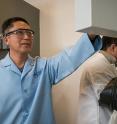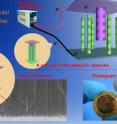Capacitor breakthrough
Related images
(click to enlarge)
Oct. 21, 2015, was the day that Doc Brown and Marty McFly landed in the future in their DeLorean, with time travel made possible by a "flux capacitor." While the flux capacitor still conjures sci-fi images, capacitors are now key components of portable electronics, computing systems, and electric vehicles.
In contrast to batteries, which offer high storage capacity but slow delivery of energy, capacitors provide fast delivery but poor storage capacity.
A great deal of effort has been devoted to improving this feature -- known as energy density -- of dielectric capacitors, which comprise an insulating material sandwiched between two conducting metal plates.
Now, a group of researchers at the University of Delaware and the Chinese Academy of Sciences has successfully used nanotechnology to achieve this goal.
The work is reported in a paper, "Dielectric Capacitors with Three-Dimensional Nanoscale Interdigital Electrodes for Energy Storage," published in Science Advances, the first open-access, online-only journal of AAAS.
"With our approach, we achieved an energy density of about two watts per kilogram, which is significantly higher than that of other dielectric capacitor structures reported in the literature," says Bingqing Wei, professor of mechanical engineering at UD.
"To our knowledge, this is the first time that 3D nanoscale interdigital electrodes have been realized in practice," he adds. "With their high surface area relative to their size, carbon nanotubes embedded in uniquely designed and structured 3D architectures have enabled us to address the low ability of dielectric capacitors to store energy."
One of the keys to the success of the new capacitor is an interdigitated design -- similar to interwoven fingers between two hands with "gloves" -- that dramatically decreases the distance between opposing electrodes and therefore increases the ability of the capacitor to store an electrical charge.
Another significant feature of the capacitors is that the unique new three-dimensional nanoscale electrode also offers high voltage breakdown, which means that the integrated dielectric material (alumina, Al2O3) does not easily fail in its intended function as an insulator.
"In contrast to previous versions, we expect our newly structured dielectric capacitors to be more suitable for field applications that require high energy density storage, such as accessory power supply and hybrid power systems," Wei says.
Source: University of Delaware
Other sources
- Capacitor breakthroughfrom Science DailySat, 24 Oct 2015, 15:42:29 UTC
- Nanotechnology offers new approach to increasing storage ability of dielectric capacitorsfrom PhysorgFri, 23 Oct 2015, 23:00:18 UTC
- Nike produces 'Back to the Future' self-lacing sneakersfrom UPIThu, 22 Oct 2015, 15:00:39 UTC
- 'Back to the Future' Day: Michael J. Fox, Christopher Lloyd celebrate pop culture eventfrom UPIWed, 21 Oct 2015, 21:30:04 UTC
- Hold on to your hoverboard: "Back to the Future" is nowfrom PhysorgWed, 21 Oct 2015, 10:00:11 UTC
- Where are the hoverboards? Professor says not too far offfrom Science DailyWed, 21 Oct 2015, 2:00:07 UTC
- Brands eye big bucks with 'Back to the Future' nostalgiafrom PhysorgTue, 20 Oct 2015, 18:20:05 UTC
- Marty McFly Time-Traveled to This Week. Did 'Back to the Future' Get It Right?from National GeographicTue, 20 Oct 2015, 13:30:17 UTC

